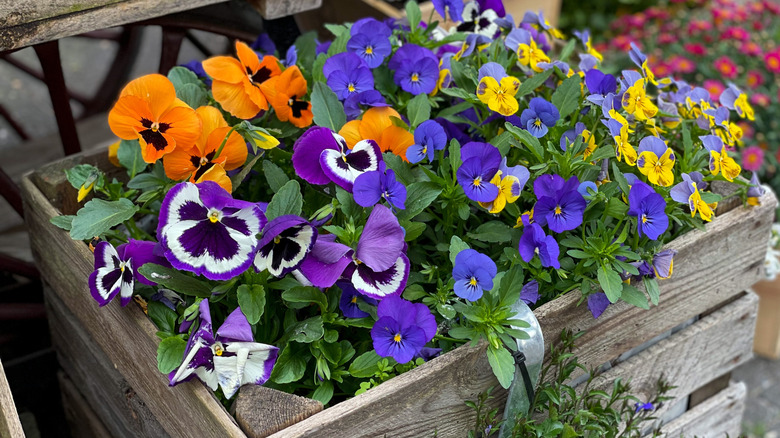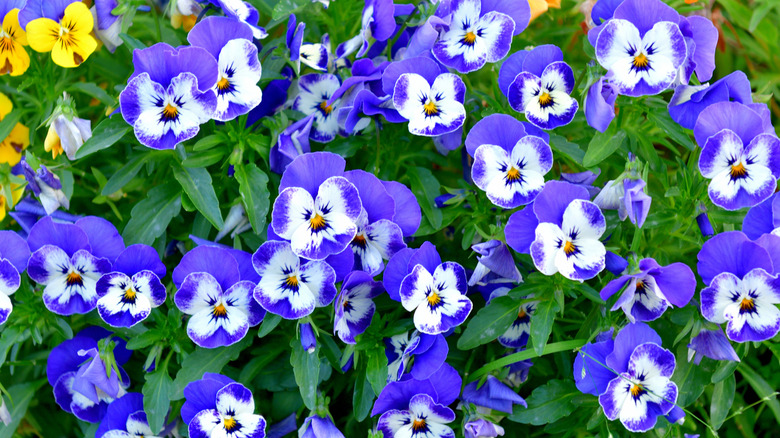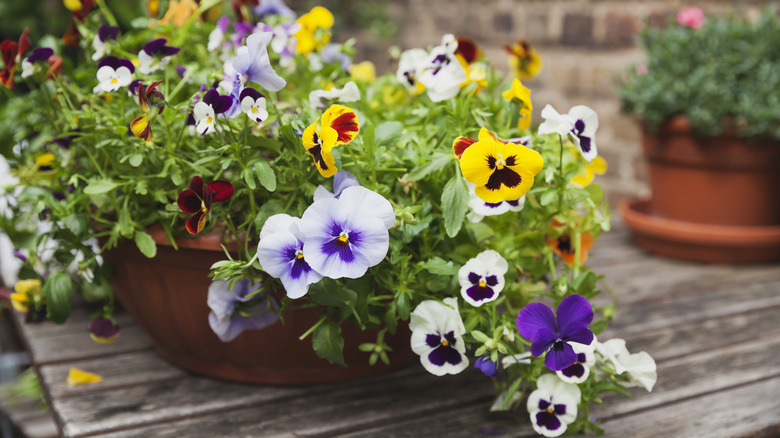Should You Grow Violas Or Pansies? Maybe Both! Here's Why
For most folks, violas and pansies are indistinguishable, but many gardeners have their firm favorites. The beloved garden staples are known for their vibrant colors and versatility and share many similarities. However, they each have unique characteristics that set them apart. Violas typically feature smaller blooms, with a more delicate appearance, and their flowers often have a pleasant fragrance. On the other hand, pansies boast larger flowers, up to three inches across, with striking blotches or "faces" on their petals, making them instantly recognizable.
If you're trying to tell them apart, one tip is to look closely at the bloom size and shape. Violas are known for producing an abundance of smaller blooms over a longer period, while pansies focus their energy on fewer but larger flowers. Both belong to the same botanical family, Violaceae, but pansies are technically hybrids of violas. With this shared lineage, they often get mistaken for one another — a testament to their botanical connection. No wonder the two blooms complement each other so perfectly when grown together.
The history of these blooms is equally fascinating. Violas, with their dainty flowers, have been cultivated for centuries and are known for their use in herbal remedies and perfumes. Pansies, derived from violas, were bred to emphasize their bold patterns and vibrant colors, and many gardeners have since chosen this flower for their bold hues. Knowing a little about their background might help you appreciate them even more as you plan your garden.
Choosing between violets and pansies
While you may think you know everything to know before planting pansies or even be an expert on how to grow and take care of violas, choosing which is best for your garden may be a bit of a challenge. One of the key features of the blooms is that they are all about the cooler weather, making them ideal for early spring or fall gardens. However, both love basking in full to partial sunlight and well-drained soil, with violas being slightly more adaptable to shady conditions. Both violas and pansies can tolerate light frosts, but violas tend to bounce back after frosts that might permanently damage pansies. So, violas may be a better choice if you experience harsh, chilly winters. In more temperate climates, pansies may be a better choice if you're looking to make a dramatic statement in your garden.
Thinking about how long these plants will stick around? Violas can surprise you by acting as perennials in mild climates, coming back year after year with just a little care. Pansies, on the other hand, are more of a short-term delight, often treated as annuals or biennials. If you're planning a flower bed, violas are perfect for those who love a long-lasting splash of color, while pansies deliver bold beauty for a single season. This distinction can influence how gardeners plan their flower beds and containers.
Tips on growing both pansies and violas
When growing violas and pansies, start by choosing high-quality seeds or healthy seedlings and planting them in nutrient-rich, well-draining soil. Adding organic compost before planting can boost soil fertility and improve drainage. For violas, deadheading spent flowers encourages continuous blooming throughout the season. Pansies, too, benefit from deadheading, but they require additional attention to spacing. Crowded pansies are prone to fungal diseases, so space plants 6 to 10 inches apart to allow for adequate airflow.
When it comes to watering, there is a common mistake that's sure to kill your pansies and adversely affect your violas too. While violas and pansies need consistent moisture, especially during hot or dry spells, avoid overwatering, as soggy soil can lead to root rot. Mulching around the plants can help retain moisture and regulate soil temperature, an especially helpful tip for warmer zones.
To extend their flowering season, consider planting violas and pansies in succession. Start with violas in early spring, as they're hardier and better equipped to handle cool conditions. Once temperatures rise, transition to pansies for a spring (and maybe summer!) burst of color. In mixed beds, violas can provide a soft underlayer to complement the bolder pansy blooms. By growing both violas and pansies, you'll enjoy a garden that's not only visually stunning but also filled with flowers that complement each other in form, function, and seasonality. So why choose one when you can have the best of both worlds?


